
Inonotus obliquus (Ach. ex Pers.) Pilat
Chaga is a parasitic fungus that grows in northern (boreal) forests on birch trees. It’s been part of Russian folk medicine since the 16th century (Spinosa, 2012, p.22-26). In fact, the word chaga comes from the Khanty language, an Indigenous people living in modern-day Russia. Chaga has only recently started to gain popularity in the United States. Inonotus obliquus (Ach. ex Pers.) Pilat (1942) is the official scientific name. The following bits of trivia come from some Wikipedia browsing. “Ino-” is a prefix meaning “fibrous” and “ot” comes from the Latin for “ear”, and that has been used as part of the scientific name for other shelf fungi. Three relevant scientists are included in the name as well. Christiaan Hendrik Persoon (1761-1836) was a mycologist from South Africa. Erik Acharuis (1757-1819) was a Swedish lichenologist. The “ex” means “from” in Latin, and meaning “validly published by” Persoon in this case. Albert Pilat (1903-1974) was a Czech botanist and mycologist specializing in polypores and boletes. Digging into the meaning and information contained within this name helps me to remember the Latin words.
Boreal distribution:
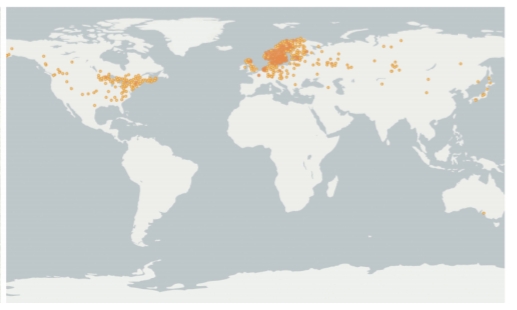
Articles:
Chaga Story (history)
Chaga Harvest in the land of the Siberian tiger (article about chaga harvest and forest management in Russia)
Chaga a Medical Marvel but a Conservation Dilemma (excellent article published in 2020)
Above are three articles about chaga, and if you can’t access them here, comment below. I already had the first two from the ethnomycology class, but I wanted to find an article that explained about the compounds within chaga and their health benefits. I quickly found an article that had all that as well as a thoughtful analysis of the implications of a sustainable harvest. I highly recommend checking out “Chaga (Inonotus obliquus): a medical marvel but a conservation dilemma?” by Thomas, Elkhateeb, and Daba if you are interested in learning more about chaga.
Thomas et al. explain the life cycle of chaga, which is a bit different than other mushrooms that I am familiar with. The fungus enters the tree through wounds, and, over 10-80 years, it causes decay and forms a sterile mycelial mass (2020, p. 123). This is the burnt-looking brownish mass that chaga harvesters seek. At this point, the chaga fungus has not yet reproduced, and it won’t until the tree is killed. After the fungus kills the tree, it will produce fruiting bodies (similar in function to the parts of culinary mushrooms that we are more familiar with) under the outer bark and push it until it breaks open. I haven’t seen this yet, nor have I come across much information about it in my research. There was a presentation at the 2020 Alaska Food Policy Council conference by Callen Christensen of the Fairbanks Chaga Co-operative. He had some photos of chaga fruiting bodies and explained that he was experimenting with chaga propagation. He encouraged anyone interested to get in touch, and here is their website: https://www.chagacoop.com/.
So far, over 200 compounds have been extracted from chaga. Various compounds are anticancer, antioxidant, anti-inflammatory, antidiabetic, and immuno-enhancing with little or no side effects. Polysaccharides and triterpenoids are two of the most powerful medicinal compounds. See the table below from Thomas et al. (2020, p.125).
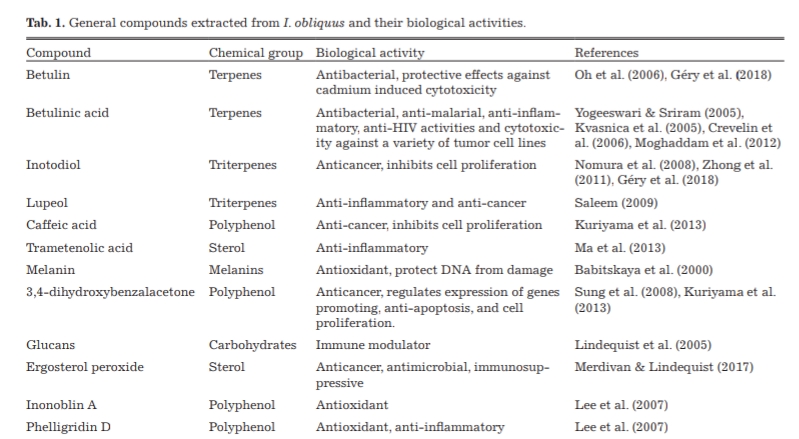
As the popularity of chaga is on the rise, this issue of sustainable harvest becomes more and more important. A 10 to 15 year-old chaga mass can weigh up to 10 pounds. According to the Alaska Non-Timber Forest Products Harvest Manual (commercial harvest on state-owned land) (2008, p. 15), the quantity limit of conk harvest, which includes chaga, is 10,000 pounds fresh weight of all species combined (included 4+ varieties of conks). Motorized equipment is allowed with the aside that no petroleum product may split on soil or vegetation. That limit seems enormous and more or less like no regulation.
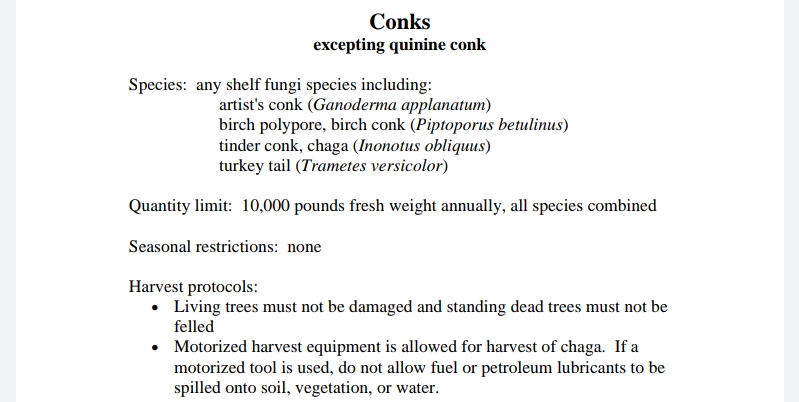
Thomas et al. write that on 10/1/2019, an Amazon search resulted in 4000+ products and that Google trends show a four-fold increase in searches over the previous 10 years (2020, p.127). They write that “we are in a situation where we are commercially harvesting large quantities of an organism of which we know very little about, with disregard for any ecological impact on the target species or those that may be interdependent” (2020, p. 127).
The authors advocate for a multi-pronged approach to this issue involving education, legislative support to protect the fungus and its environment until more research is complete, plus support of chaga cultivation. Cultivation is an interesting topic. Growing mycelium is what Paul Stamets’ company Fungi Perfecti in Olympia, Washington, does but it lacks some of the compounds found in the wild-harvested chaga. Some compounds, like betulinic acid (which shows strong results in anti-cancer studies), are created through the fungus’ interaction with the host tree and are not present in cultivated lab strains. Thomas et al. describe a project of innoculating birch trees and growing chaga big enough to harvest within three years, but they warn that not enough is known about the effect on the forest of speeding up that process (2020, p. 128).
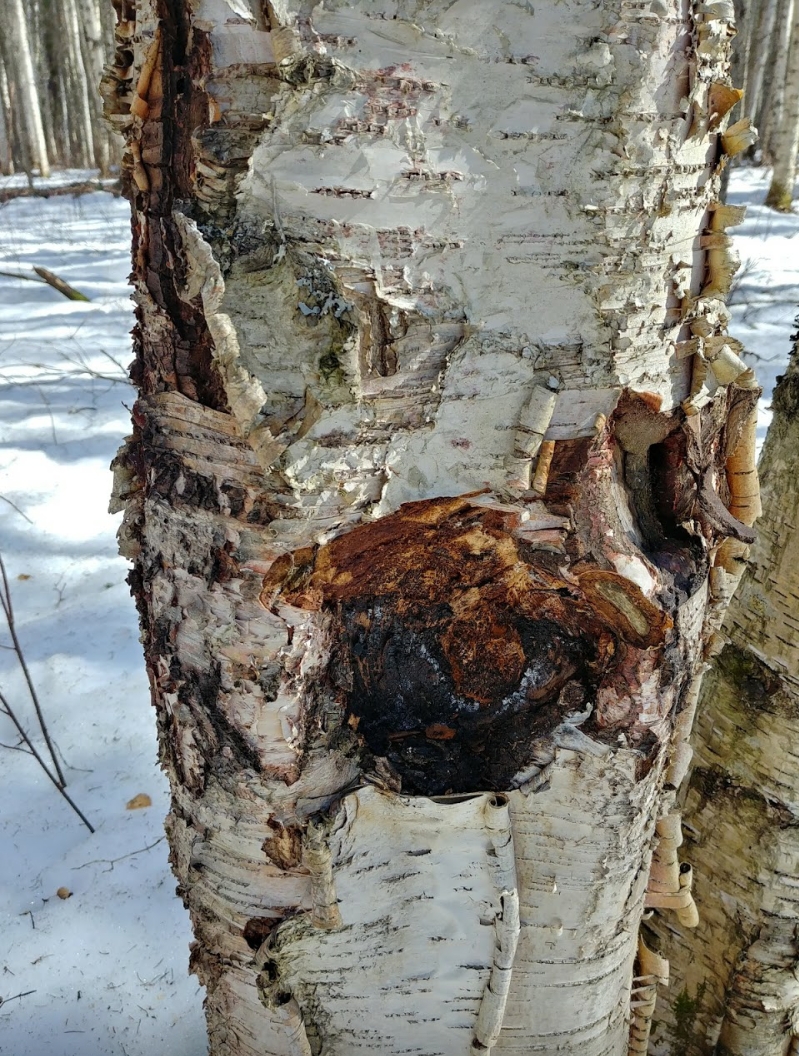
Project:
I definitely regard the chaga tincture that I made with gratitude after learning about the chaga reproductive process. I harvested some chaga on a sunny May weekend out Chena Hot Springs Road in Fairbanks, Alaska. Then I broke it into uniform pieces and let it dry for a week or two. I then froze it until I was ready to use it.
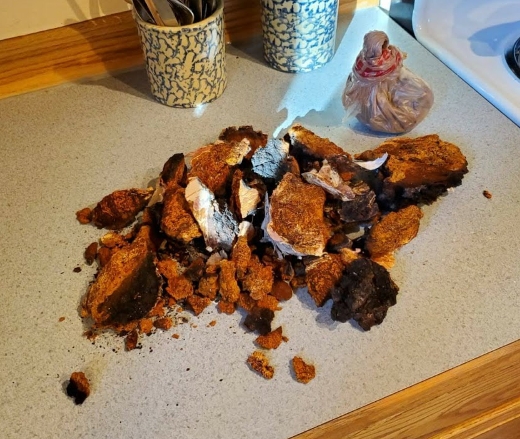
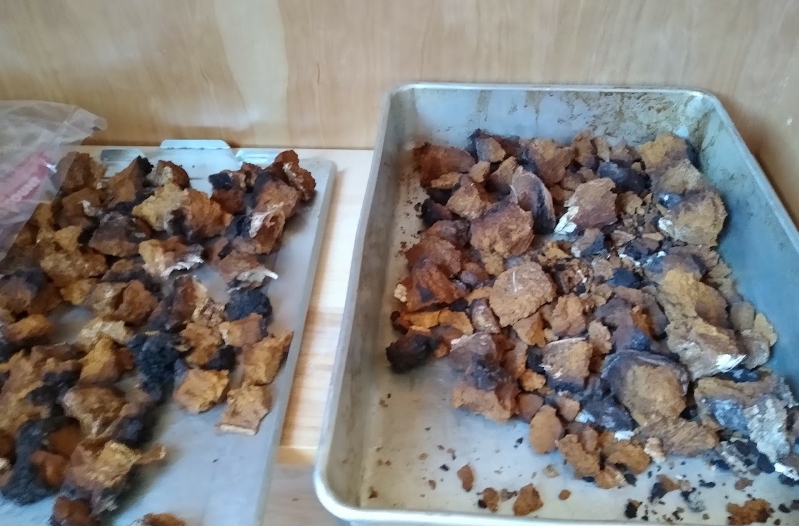
I decided to try a double extraction because I had never made one. I still feel vaguely confused about the process as far as the steps and mathematical ratios go. I read about a lot of peoples’ projects online, and then specifically used two websites (links in references below) plus Beverly Gray’s book. The reason that double extractions are good to make from harder woody mushrooms (reishi, turkeytail, and chaga) is that the fungi contain compounds that are soluble in water and others that are soluble in alcohol. The result is a shelf stable liquid that retains as much of the medicinal compounds as possible. A double extraction is a combination of a decoction (simmering or steeping in water) and a tincture (soaking in alcohol). Some recipes suggest using fresh mushrooms for each part, some call for the water extraction first and then the alcohol process, and some are the opposite. I liked the idea of using the same chaga pieces for both steps to be less wasteful and more respectful of the fungus. Some recipes say that doing the alcohol extraction first destroys some of the water-soluble compounds in the chaga, so next time, I may reverse the order that I did for this project.
First a measured out a jar of chaga. Then I ground the pieces in the coffee grinder until it started to overheat. I left a few bigger chunks. I measured out Everclear alcohol (75% ABV) and it took 2 cups to completely cover the chaga. I shook it and put it in a dark cupboard.

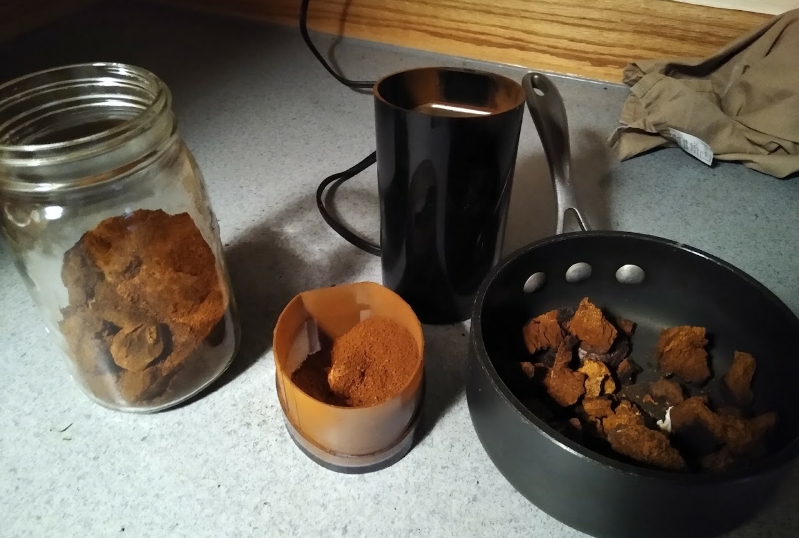
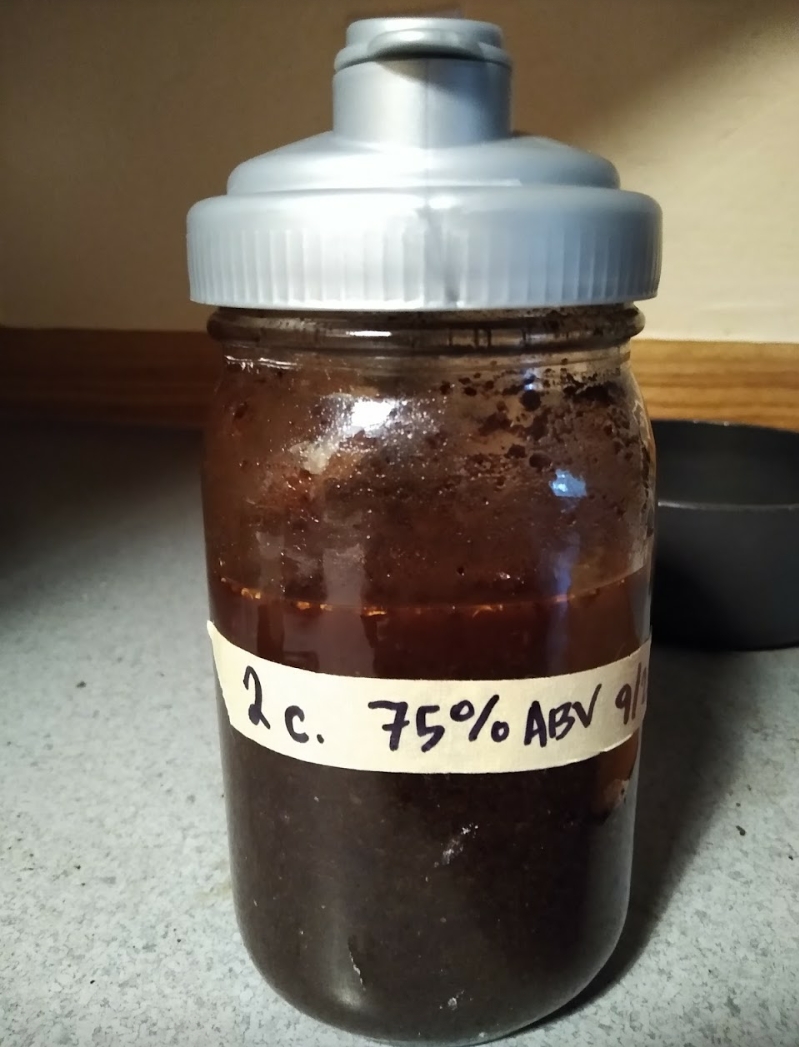
I thought I was clever using one of my plastic lids that I use for fermentation. Instead, by the next time I check on it, most of the alcohol had evaporated. I added an additional cup of alcohol (and a proper lid) to re-cover the chaga and tried not to wonder too much what that would do to later measurements.
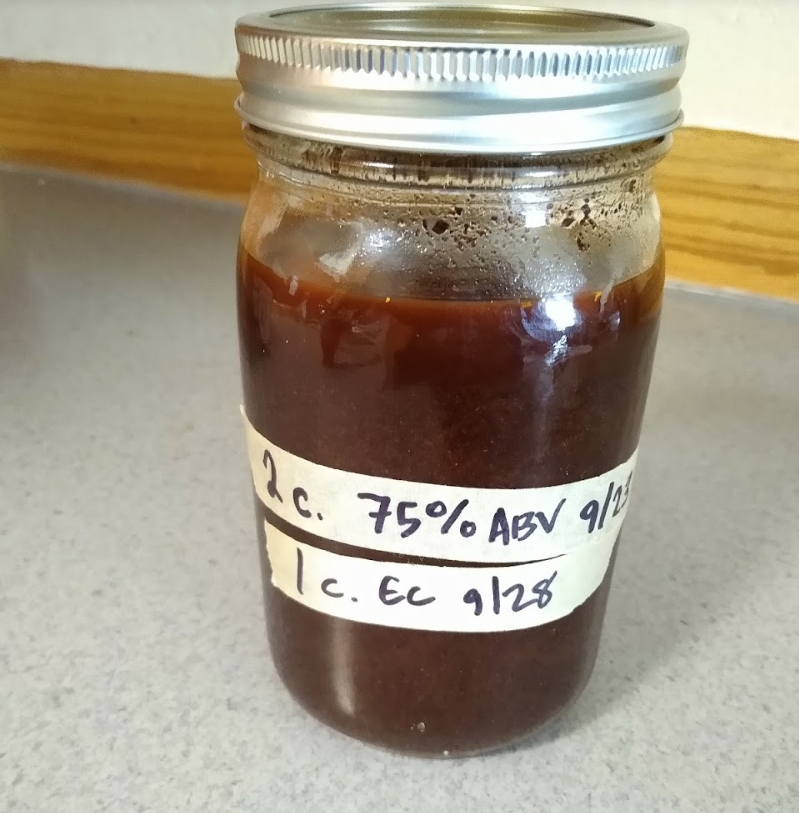
Then after about a month, I strained out the alcohol. There wasn’t very much liquid released from the chaga, and it’s not something you can sort of wring out like other plant material. I did the best I could and threw the rest in a pot with a few cups of water. My goal was to simmer it for several hours, adding water when necessary, and eventually end up with a water extraction (decoction) to mix with the alcohol extraction (ticture).


It was harder than I expected to keep from boiling off all the water. I also miscalculated and thought I needed 1/3 the amount of the alcohol extraction so that when I mixed the two, the result would be shelf stable. I think I could have done a 1:1 ratio and had a little more product. But overall, I learned a lot and am happy with the result.


Video of the decoction process (I put off making this video for so long because I thought it would be hard. What actually happened is that I used the movie making feature in Google Photos, and it was super easy!):
References:
Chaga co-operative: “Alaskan forager’s co-operative”. (2020). Retrieved on 7 December 2020 at https://www.chagacoop.com/.
Gray, Beverly. (2011). The boreal herbal: Wild food and medicine plants of the North. Aroma Borealis Press.
Hutchison, M. How to make a mushroom double extraction. (19 Oct 2015). Mountain Rose Herbs. Retrieved from https://blog.mountainroseherbs.com/mushroom-double-extraction.
Pilz, D. (2012) Chaga harvesting in the land of the Siberian tiger. FUNGI, 5(3), 13-17.
Spinosa, R. (2012) The chaga story. FUNGI, 5(3), 23-26.
State of Alaska Department of Natural Resources Division of Mining, Land and Water (2 Apr 2008). Alaska non-timber forest products harvest manual for commercial harvests on state-owned land. Juneau, Alaska. Retrieved from http://dnr.alaska.gov/mlw/ntfp/.
Thomas, P., Elkhateeb, W.A., Daba, G.M. (2020). Chaga (Inonotus obliquus): a medical marvel but a conservation dilemma? Sydowia, 72, 123-130.
White, A. Crafting chaga double extract. (10 Jan 2008) Iowa Herbalist. Retrieved from https://iowaherbalist.com/2018/01/10/make-chaga-double-extract/.
Posted: December 2020.



